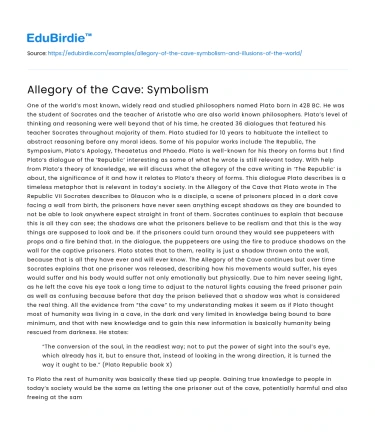One of the world’s most known, widely read and studied philosophers named Plato born in 428 BC. He was the student of Socrates and the teacher of Aristotle who are also world known philosophers. Plato’s level of thinking and reasoning were well beyond that of his time, he created 36 dialogues that featured his teacher Socrates throughout majority of them. Plato studied for 10 years to habituate the intellect to abstract reasoning before any moral ideas. Some of his popular works include The Republic, The Symposium, Plato’s Apology, Theaetetus and Phaedo. Plato is well-known for his theory on forms but I find Plato’s dialogue of the ‘Republic’ interesting as some of what he wrote is still relevant today. With help from Plato’s theory of knowledge, we will discuss what the allegory of the cave writing in ‘The Republic’ is about, the significance of it and how it relates to Plato’s theory of forms. This dialogue Plato describes is a timeless metaphor that is relevant in today’s society.
In the Allegory of the Cave that Plato wrote in The Republic VII Socrates describes to Glaucon who is a disciple, a scene of prisoners placed in a dark cave facing a wall from birth, the prisoners have never seen anything except shadows as they are bounded to not be able to look anywhere expect straight in front of them. Socrates continues to explain that because this is all they can see; the shadows are what the prisoners believe to be realism and that this is the way things are supposed to look and be. If the prisoners could turn around they would see puppeteers with props and a fire behind that. In the dialogue, the puppeteers are using the fire to produce shadows on the wall for the captive prisoners. Plato states that to them, reality is just a shadow thrown onto the wall, because that is all they have ever and will ever know.
Save your time!
We can take care of your essay
- Proper editing and formatting
- Free revision, title page, and bibliography
- Flexible prices and money-back guarantee
The Allegory of the Cave continues but over time Socrates explains that one prisoner was released, describing how his movements would suffer, his eyes would suffer and his body would suffer not only emotionally but physically. Due to him never seeing light, as he left the cave his eye took a long time to adjust to the natural lights causing the freed prisoner pain as well as confusing because before that day the prison believed that a shadow was what is considered the real thing. All the evidence from “the cave” to my understanding makes it seem as if Plato thought most of humanity was living in a cave, in the dark and very limited in knowledge being bound to bare minimum, and that with new knowledge and to gain this new information is basically humanity being rescued from darkness. He states:
“The conversion of the soul, in the readiest way; not
to put the power of sight into the soul’s eye, which already
has it, but to ensure that, instead of looking in the wrong direction,
it is turned the way it ought to be.” (Plato Republic book X)
To Plato the rest of humanity was basically these tied up people. Gaining true knowledge to people in today’s society would be the same as letting the one prisoner out of the cave, potentially harmful and also freeing at the same time.
Each symbol acknowledged in the allegory of the cave has a significance, from the puppet-master that symbolizes individuals and organizations who construct knowledge to the chains which symbolize anything that keeps the individual from having the freedom to learn. The other important symbol is the sun as it is the only true light, and this light symbolizes how people accurately see the world. Socrates explains:
“When they [the eyes] are directed towards objects on
which the sun shines, they see clearly and there is sight in them?
Certainly.
And the soul is like the eye: when resting upon that on
which truth and being shine, the soul perceives and understands
and is radiant with intelligence.” [508](248-249)
Plato’s theories have many of the same themes throughout, In the cave the prisoners go from the dark of the cave to the light of outdoors, showing us limitations and how knowledge can get us beyond our previous limitation, this also infers to show us how our knowledge can be a limitation if we do not keep searching and educating ourselves. The Forms show us that even though we can see something does not mean we can see all of it and just because we cannot see something does not mean it does not exist. All three-link knowledge as the key to all; anything and everything. If you have infinite knowledge there is nothing you cannot have.
Further support for this claim comes again from the allegory of the cave as it contains many forms of symbolism used to describe the illusions of the world. The cave represents the superficial world for the prisoners. The chains that prevent the prisoners from leaving the cave represent ignorance, meaning the chains are stopping them from learning the truth. The shadows that cast on the walls of the cave represent the superficial truth, which is an illusion that the prisoners see in the cave. The freed prisoner represents those in society who see the physical world for the illusion that it is. The sun that is glaring the eyes of the prisoners represents the real truth of the actual world. The allegory of the cave was about all these people in a cave being fed fake realities and in turn if they ever saw the real world then to them it would probably turn their world upside down.






 Stuck on your essay?
Stuck on your essay?

